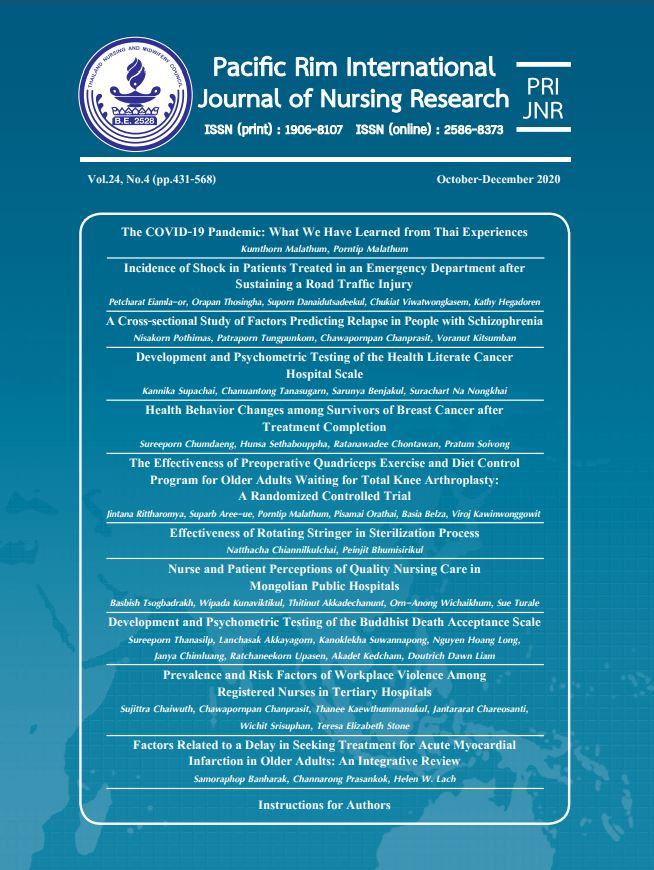The Development and Psychometric Testing of the Buddhist Death Acceptance Scale
Keywords:
Acceptance, Buddhists, Cancer, Death, Instrument development, Psychometric TestingAbstract
Death acceptance relates to a good death of people. Notably each culture/religion has its own traditions,beliefs,andpractices surrounding death which has been handed down for centuries.Culture/religion creates not only the meaning of death but also often influences how people die.To date the measurement of death acceptance, especially from a religious perspective has not been widely developed.This research was conducted to develop and psychometrically test the Buddhist Death Acceptance Scale for Cancer reflecting Buddhists’ beliefs towards karma and three characteristics of existence.Using a multistage sampling method, Buddhists diagnosed with cancer from six hospitals in four regions of Thailand were recruited into the study from April 2018 to January 2019.Exploratory factor analysis was conducted in the first group of 300 participants.
The final version of the questionnaire had 13 items in two components that explained 45.87% ofthe variation of the construct.These two dimensions were:1)acceptance ofthe natural process of death and 2)preparing for death. Confirmatory factor analysis was performed in with230 participants.The results showed that the two-dimension construct of the scale fit with the empirical data.The Cronbach’s alpha coefficient was 0.82.In conclusion the Scale demonstrated acceptable psychometric properties to measure death acceptance in Buddhists who are diagnosed with cancer.Nurses and other healthcare professionals can use this scale as a tool for evaluating death acceptance and intervention effectiveness among Thai Buddhists with cancer.In addition next steps include testing the Scale for use with Thai Buddhists at end-of-life with illnesses other than cancer and translating it into other languages to test for use with Buddhists worldwide.
References
Akkayagorn L. Death acceptance. Chula Med J 2018; 62(5):761-72. doi: 10.14456/ clmj. 2018.10.
Marcysiak M, Dąbrowska O, Marcysiak M. Acceptance of death as a life attitude for nurses and nursing students. Prog Health Sci 2013; 3(1):104-10.
Long NH, Thanasilp S, Doutrich DL. Death acceptance in Vietnamese cancer patients: a phenomenological study. J Transcult Nurs 2018; 29(6):563-69. doi: 10.1177/1043659618 765081.
Zimmermann C. Acceptance of dying: a discourse analysis of palliative care literature. Social Science & Medicine 2012; 75(1):217-24. doi: 10.1016/ j.socscimed. 2012.02.047.
Semino E, Demjen Z, Koller V. ‘Good’ and ‘bad’ deaths: narratives and professional identities in interviews with hospice managers. Discourse Studies 2014; 16(5):667-68. doi. org/10.1177/1461445614538566.
McLeod-Sordjan R. Death preparedness: a concept analysis. J Adv Nurs 2014; 70(5):1008-19. doi: 10.1111/jan.12252.
Reker GT, Peacock EJ. The life attitude profile (LAP): a multidimensional instrument for assessing attitudes
toward life. Can J Behav Sci 1981; 13:264-73.
Gesser G, Wong PTP, Reker GT. Death Attitudes across the life-span: the development and validation of the death attitude profile (DAP). Omega 1988; 18(2):113-28. doi.org/ 10.2190/ 0DQB-7Q1E-2BER-H6YC.
Wong PTP, Reker GT, Gesser G. Death attitude profile-revised: a multidimensional measure of attitudes toward death (DAP-R) in Death anxiety handbook: research, instrumentation, and application. Washington, DC: Taylor & Francis; 1994.
Pinquart M, Frohlich C, Silbereisen RK, Wedding U. Death acceptance in cancer patients. Omega 2006; 52(3):217-35. doi.org/10.2190/E5F0-GJUX-AM68-4777.
Wolpert L. How the fear of death gave birth to religion. New Humanist. 2017. Available from:https://newhumanist. org.uk/articles/5282/how-the-fear-of-death-gavebirth-to-religion [Accessed 5th February 2020].
Macmillen H. 5 different religions & how they with their dead. 2015. Available from: https://www.refinery29.com/en-us/religious-death-beliefsDeal [Accessed 8th January 2020].
Buddhaghosacariya S. Buddhadhamma: The laws of nature and their benefits to life. Bangkok:Buddhadhamma Foundation. 2019.
Teinthawan W. Dharma Pluzzle: “Hidden gems by Buddhathas Piku (2).” Matichon Online. September 1, 2019. Available from: https://www.matichon.co.th/columnists/news_1650392 [Accessed 27th February 2020].
Thanaratho P. The compare study the death of Buddhathas with Albert Camus. PRIJ 2015; 2(2):143-50.
Devellis RF. Scale development: theory and applications. 4th ed. Thousand Oaks: CA: SAGE Publications, Inc.; 2016.
Gray J, Grove S. Understanding nursing research: building an evidence-based practice. 7th ed. Saunders; 2018.
Auerswald M, Moshagen M. How to determine the number of factors to retain in exploratory factor analysis: a comparison of extraction methods under realistic conditions. Psychol Methods 2019; 24(4):468-91. doi: 10.1037/met0000200.
Polit DF, Beck CT. Nursing research: generating and assessing evidence for nursing practice. 10th ed. Philadelphia: Wolters Kluwer Health, Philadelphia; 2017.
Yusoff MSB. ABC of content validation and content validity index calculation. EIMJ 2019;11(2):49-54. doi.org/
21315/eimj2019.11.2.6.
Eunike W, Samuel G. The world beyond rating scales: Why we should think more carefully about the response format in questionnaires. Eur J Psychol Assess 2018; 34(1):1-5. doi.org/10.1027/1015-5759/a000469.
Watkin MW. Exploratory factor analysis: a guide to best practice. J Black Psychol 2018; 44(3):219-46. doi.org/10.1177/0095798418771807.
Lewis TF. Evidence regarding the internal structure: confirmatory factor analysis. Meas Eval Couns Dev 2017; 50(4):239-47. doi.org/ 10.1080/ 07481756.2017. 1336929.
Taber KS. The use of Cronbach’s alpha when developing and reporting research instruments in science education. Res Sci Educ 2018; 48:1273-96. doi.org/ 10.1007/s11165-016-9602-2.
Chaiviboontham S, Phinitkhajorndech N, Hanucharurnkul S, Noipiang T. Psychometric properties of the Thai Spiritual Well-Being Scale. Palliat Support Care 2016; 14(2): 109-17. doi: 10.1017/S1478951515000024.
Downloads
Published
How to Cite
Issue
Section
License
Copyright: The Pacific Rim International Journal of Nursing Research, Thailand Nursing & Midwifery Council has exclusive rights to publish, reproduce and distribute the manuscript and all contents therein.








.png)



